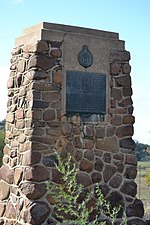Sand River Convention
 As depicted in the Voortrekker Monument | |
| Type | Delimitation of territory and rights |
|---|---|
| Signed | 17 January 1852 |
| Location | Sand River, Orange Free State |
| Signatories |
|
| Language | English |
The Sand River Convention (Afrikaans: Sandrivierkonvensie) of 17 January 1852 was a convention whereby the United Kingdom of Great Britain and Ireland formally recognised the independence of the Boers north of the Vaal River.[1]
Background[]
The convention was signed on 17 January 1852, by Commandant-General Andries Pretorius and others, on behalf of the new country, and Major William Samuel Hogge and Charles Mostyn Owen, clerk to the Civil Commissioner of Winburg, duly authorised to, and on behalf of, the British government. The treaty was signed on the farm called Sand River belonging to P. A. Venter, near Ventersburg.
Provisions[]
The treaty contained the following provisions:
- The British government guarantees and grants the emigrant farmers across the Vaal river the right to govern themselves, according to their own laws free from any and all British interference and that the British Government wishes to promote peace, free trade and friendly intercourse with the new country
- Britain disclaims any and all alliances with coloured nations to the North of the Vaal river
- No slavery be practised in the country to the North of the Vaal river
- Ammunition and arms crossing over the border from the South of the Vaal river shall require a certificate from a British Magistrate, and that no arms or munitions be supplied to the natives by either the British or by the people of the new country
- Criminals will be exchanged between the British and the new country and that summonses for witnesses from both sides of the river be backed up by the magistrates at both sides of the river
- It is agreed that certificates of marriages will be recognised on both sides of the river
- It is agreed that any and all people now residing in British land but being in possession of land in the new country shall have the free right to sell the property and to move freely over the Vaal river.
Claims of contraventions[]

South African Republic authorities claimed the British contravened the treaty in 1853, with an English citizen, the missionary Livingstone supplying, storing and causing repairs to materials of war to the native tribes. Commandant Scholtz and his men confiscated a large number of rifles and amounts of ammunition and equipment from the home of David Livingstone.[2] The British in turn claimed that the Boers were keeping slaves under the Inboekstelsel system. The Boers responded that the acts of a few criminals and criminal gangs cannot be claimed to be that of an entire nation.
First Boer War[]
One of the causes of the First Boer War was the direct breach by the British of this convention on 12 April 1877. Britain issued a proclamation called: "Annexation of the S.A. Republic to the British Empire,"[3] and proceeded to occupy Pretoria. Although the British did not attempt to dismantle the country, and self-rule was decreed in the proclamation, the annexation was not accepted by the South African Republic, and a delegation was sent to Europe and the United States to protest this action.
References[]
Footnotes[]
- ^ Eybers 1918, pp. 357–359.
- ^ Kruger 1902, p. 40.
- ^ Eybers 1918, pp. 448–449.
Bibliography[]
- Eybers, G. W. (1918). Select Constitutional Documents Illustrating South African History, 1795–1910. London: Routledge. OCLC 877689.
- Kruger, P. (1902). The memoirs of Paul Kruger, four times President of the South African Republic. Toronto: Morang. OCLC 890954475.
Coordinates: 28°13′55″S 27°05′21″E / 28.23194°S 27.08917°E
- 1850s in the South African Republic
- 1852 establishments in Africa
- 1852 in South Africa
- 1852 treaties
- South Africa–United Kingdom relations
- Treaties of the South African Republic
- Treaties of the United Kingdom (1801–1922)
